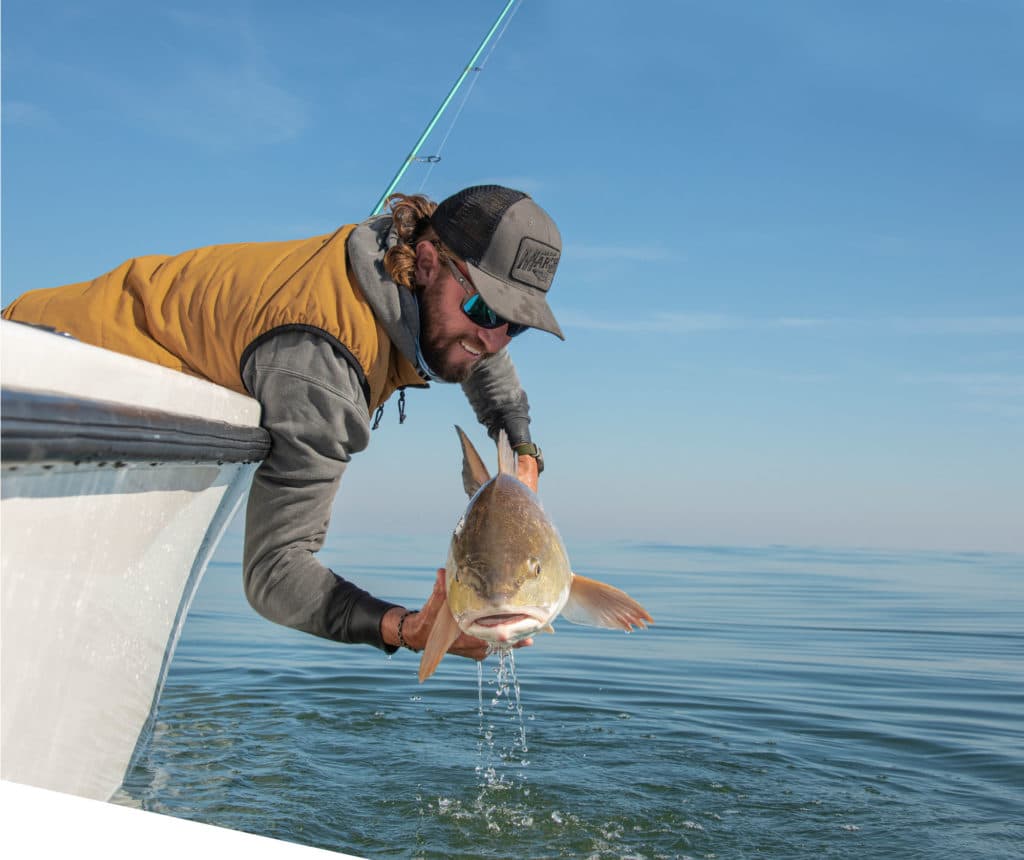
Florida West Coast
The Florida Gulf coast, from Fort Myers to the Big Bend, is one of the Southeast’s most fertile regions for reds. Why? Lots of fishy habitat.
From the north end of the Everglades to the Big Bend, reds graze on grass flats with scattered potholes and a grass-and-sand mixture known as broken bottom. Rich with finfish, crustaceans and invertebrates, seagrass abounds throughout the bays and sounds in the area.
From Port Richey to St. Marks, limestone and the mangrove shorelines of southwest Florida fade into salt marsh. Sprinkled along the coast, oyster bars, docks and seawalls also come into play.
Tampa Bay guide Capt. Mike Goodwine looks for clear water, tidal flow and travel lanes. A deep artery flanking the mangroves edge or cutting through a flat narrows his focus.
“I call that ‘the highway.’ Those redfish have a certain way they’re going to run,” Goodwine says. “I use Google Earth a lot to find troughs or ditches that run along the mangroves and then fade off onto the flat.
“They ride this path in on a rising tide, and as the tide drops, they’ll ride it out. Finding these highways makes redfishing more predictable.”
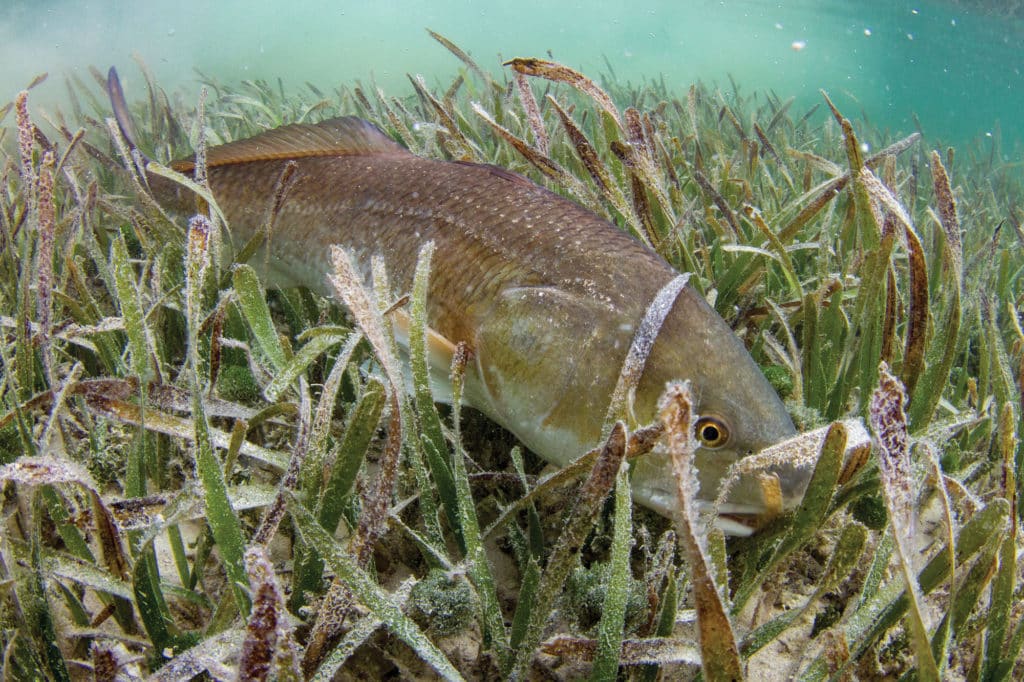
Goodwine calls spring and fall his prime times, with September taking top billing. The spring action ignites when water temps reach 72 to 73 degrees. Summer heat limits the bite to early mornings and late afternoons, until fall cooling begins.
Redfish are not picky, but Goodwine offers spring reds live pilchards (whitebait) on 1/0 circle hooks. When summer decreases the reds’ interest in chasing, he’ll switch to pinfish. If the pinfish bite dwindles, Goodwine goes to live shrimp.
“In fall, I reverse the order all the way into winter,” he says. “Shrimp is best in summer and winter, but during summer and fall, cut threadfin chunks are very productive.”
For artificials, it’s hard to beat a gold weedless spoon, which plows through seagrass and bumps across rock or shell bottom. Note: A split ring and swivel minimize line twist.
Hopping and twitching 1/8- to 3/16-ounce leadhead jigs rigged with a paddle or curly tail, or slender jerkbait tempts reds, while a synthetic shrimp under a popping or clacking cork works wonders on deeper flats. Reds will crush walking or popping topwaters, but even a missed strike refines your search.
Goodwine’s tip: When you catch that first red, resist the selfie urge and keep casting (chumming with live bait or cut shrimp helps). Reds are rarely alone and, particularly in well-defined scenarios like mangroves, docks and oyster bars, one bite can launch a rod-bending rally. —David A. Brown
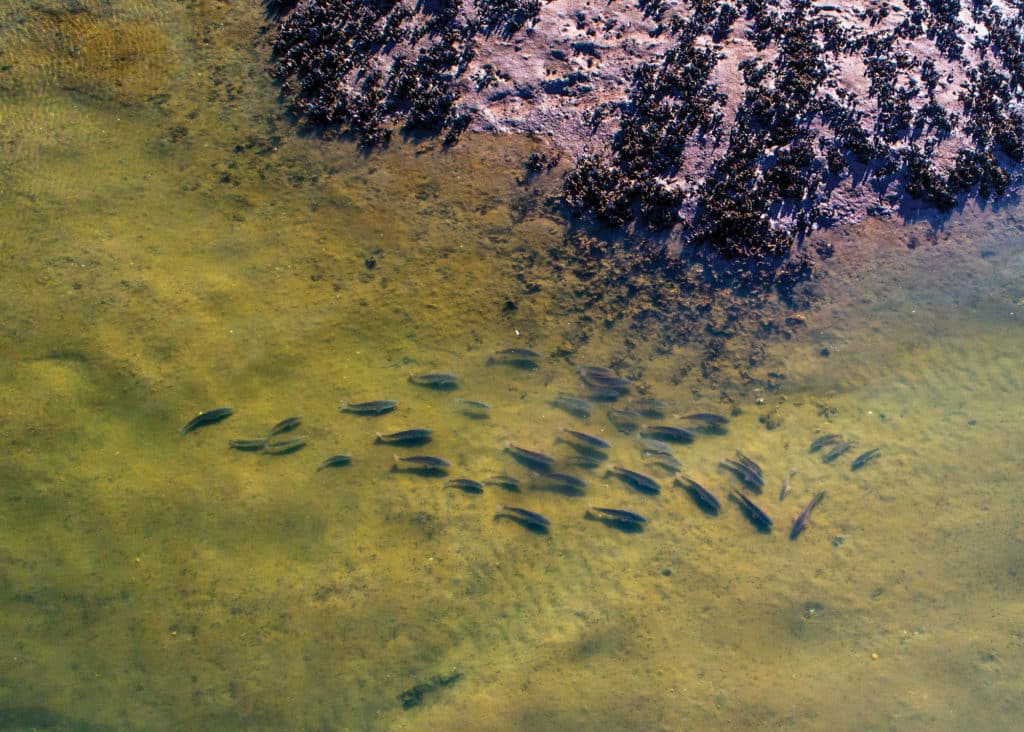
Ten Thousand Islands
The shear size and mazelike characteristics of this region keep angling pressure low in the Ten Thousand Islands and the Everglades Gulf coast. In spring and summer, when anglers concentrate on the migrating tarpon, redfish hangouts are left unattended, boosting chances for anglers who opt to pursue the spot tails instead.
Weaker than in other areas, tidal flow here seldom carves depressions and troughs for reds to stage between tide changes. But the tides still play a role, and seasoned redfishers plan stops based on their rise and fall, as well as weather and wind.
“When I see cumulus clouds, a north wind and a low falling tide, I like my chances of finding redfish action,” says Capt. Jeff Legutki (naplesfloridaflyfishing.com)of Naples, Florida. He knows cumulus clouds mean fair, stable weather, and a north wind in the Ten Thousand Islands blows offshore, keeping the water clean and low, ideal for sight-fishing. A falling tide approaching the bottom of its cycle reduces the areas reds can access, making them easier to find. A hard northerly blow coinciding with an outgoing tide may lower water levels to extremes, rendering productive spots unfishable. A west wind pushes in more—but dirtier—water, making the search for redfish more challenging.
Legutki says that once water temperatures rise above 80 degrees, fewer fish frequent back bays, preferring the cooler Gulf waters. Many abandon mangrove shorelines and cruise in the open, but he warns against wasting time in areas with bare bottom without grass or oysters, which harbor the forage redfish seek and reduce the amount of silt in the water.
Always focused on sight-fishing, Legutki limits blind-casting to periods of poor visibility and water clarity, when instead of spotting reds, he starts to see muddy swirls left by fish fleeing from his skiff. His preferred lure and fly colors are simple and direct: “For me, black with a little bit of flash is the best all around.” —Alex Suescun
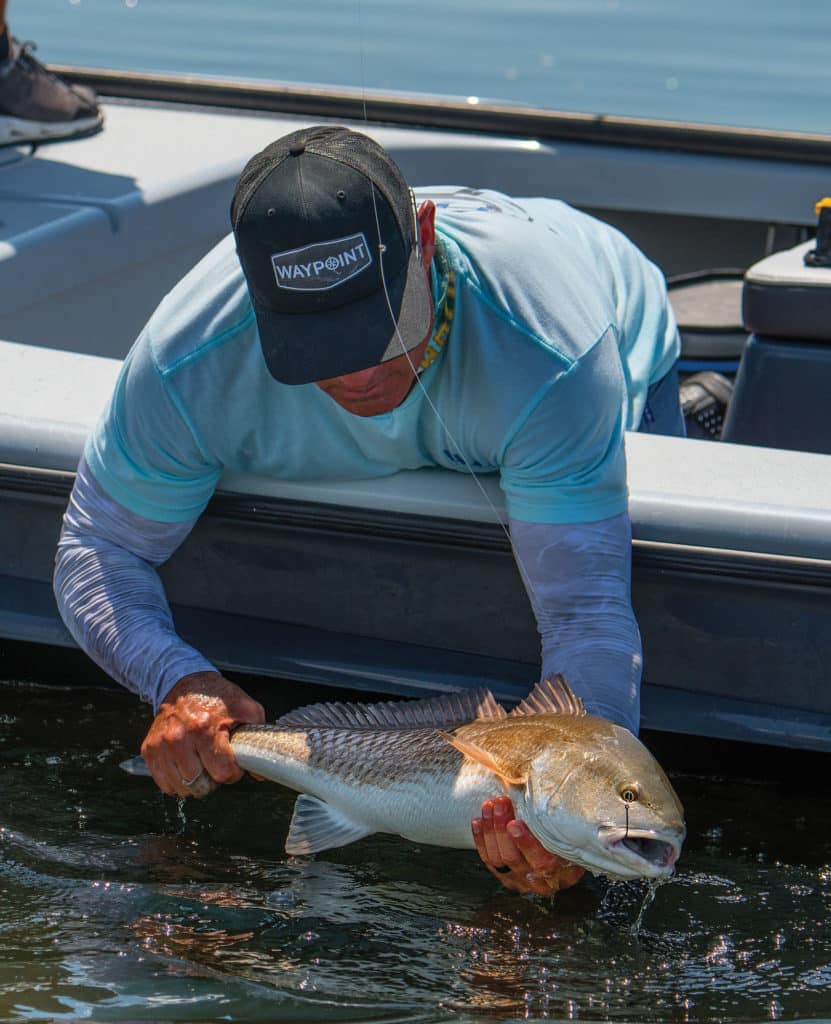
Texas Coast
The ability of Texas redfish to adapt to challenging conditions is rivaled only by the feral hog. Temperature extremes, hurricanes, hyper-salinity, hypo-salinity, drought, flood—reds take them all in stride. Thanks to conservation and strategic management, the species has rebounded from the near decimation of purse seining and gill-netting in the past.
In the southeast part of the state, where Texans share the Sabine River with our friends in Louisiana, catching reds isn’t hard, described by one expert as “consistent as magnetic north.” Numbers and size in southeast Texas has been on the rise, and top-end fish—schools of them—crowd 30 inches.
The Galveston Bay system has no shortage. If there’s any issue with reds here, it’s finding an unoccupied shoreline to wade or drift.
On the middle coast—Matagorda Bay and Port O’Connor—the story is similar. Guides target trout in the morning, and then “go get” their reds midmorning.
Scott Null captains in ultra-skinny water, from Port O’Connor south. “After [Hurricane] Harvey,” he says, “I found thousands of tiny redfish tailing just like the big guys.”
Now, he says, those fish are longer than 20 inches, and they’re all over the place and growing.
“The next two years should be excellent,” Null adds, “as those fish finish out their time in the bay.”
Extreme South Texas doesn’t have much deep water or tidal flow. Wind moves the water and the fish, and they’re always in pursuit of forage.
Natural baits, dead or alive, primarily shrimp under popping corks, turn the noses of redfish anywhere in Texas. In the right spot, throw what’s handy.
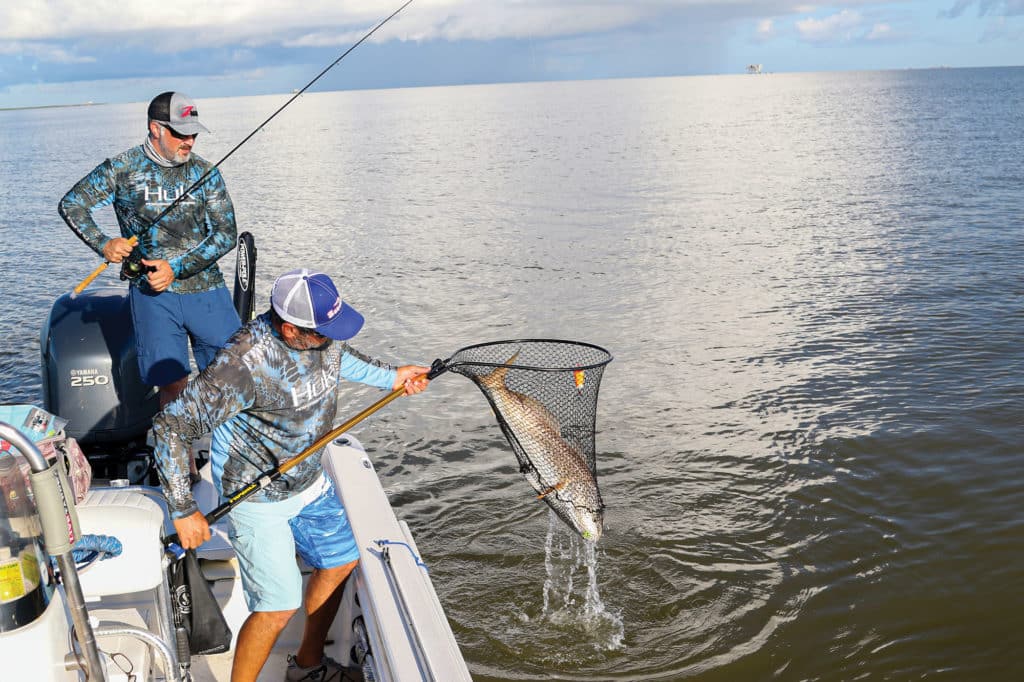
Soft-plastic jigs take more redfish than other lures, but they’re also thrown the most. The farther east in Texas you travel, the more spinnerbaits and crankbaits you’ll see. Along the middle coast, weedless spoons and topwaters tie for second behind jigs. In deep South Texas, it’s still soft-plastics, often unweighted, and more topwaters.
Null is quick to add flies to the list. Fly-fishing is his passion, and he leads dozens of fishermen to their first and largest reds each year.
Generally, strategy for Texas redfish more often starts with where than how; target marsh lakes and shallow bay shorelines when water levels are steady or rising, and fish drains and deeper structure otherwise. Reds go where there’s food, mostly shallow but occasionally deep, and feed alongside speckled trout. Overall, most reds are caught in water that won’t cover a yardstick.
I wrote 20 years ago that redfish could survive and flourish in a bucket of damp sawdust. They haven’t changed, except that there are lots more of them now than then. —Doug Pike
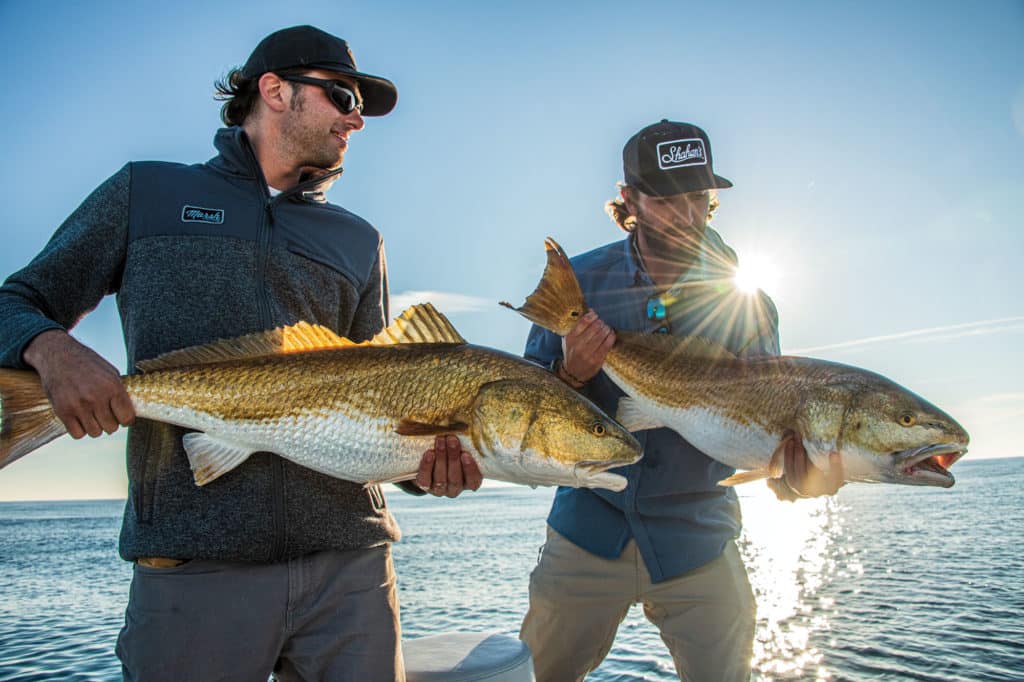
Florida Panhandle
For anglers seeking redfish diversity, few spots rival the Florida Panhandle and Alabama Gulf coast. From back bays and shallow flats to open Gulf waters, reds ranging from rats to full-grown bulls offer endless possibilities. The crystal-clear depths of Florida’s Emerald Coast is the epicenter, although similar conditions are common from the Ochlockonee River to Mobile Bay.
Capt. Wes Nelson (destinbayfishing.com) has been guiding for a decade, and is also a veteran tournament contestant.
“My favorite time is October and November on falling tides, but spring is always fun when the weather is nice,” Nelson says. “During the winter months, the water is even clearer than normal, and lower too. Since the reds will stay on the flats year-round, winter is a great time to sight-fish for them.”
Flats fish typically travel in singles and pairs, and occasionally in small schools. The bottom is a mix of white sand and turtle grass, and Nelson looks for fish cruising the edges. Docks also hold fish, which average from 3 to 61/2 pounds in the bays and flats.
“For slot-limit-size fish, I target depths of 3 feet or less. Usually we’re throwing 1/2-ounce gold spoons or softplastics with 1/4- or 1/8-ounce jig heads. Gulp! Shrimp or paddle-tail grubs like the MirrOlure Marsh Minnow Jr. are my favorites. Clear or Electric Chicken patterns are good in normal conditions. I’ll switch to slightly darker or something with flakes to add flash if the water is stained.”
For keeper-size fish, Nelson uses spinning combos with 2500- or 3000-class reels with 15-pound braid and 20-pound leaders, mounted on 7- to 7 1/2-foot medium rods. Over-slot or bull reds are prevalent in the passes during autumn and off the beaches through the winter. These fish run well into the double-digit weights and the 40-plus-inch category, so tackle is accordingly scaled up, and 5000- or 6000-class reels are called into action. Live croakers, spots and pinfish soaked on the bottom on Carolina rigs during outgoing tides are seldom refused. But Nelson prefers casting when targeting the wintertime schools off the beach.
“The seas are often calm with the prevalent north winds, so I just go looking and hunting. The reds are keying in on mullet and greenies that time of year. I love to throw Skitter Walk topwater lures, but any kind of loud popper will also get their attention. It’s really a blast.” —Capt. Dave Lear
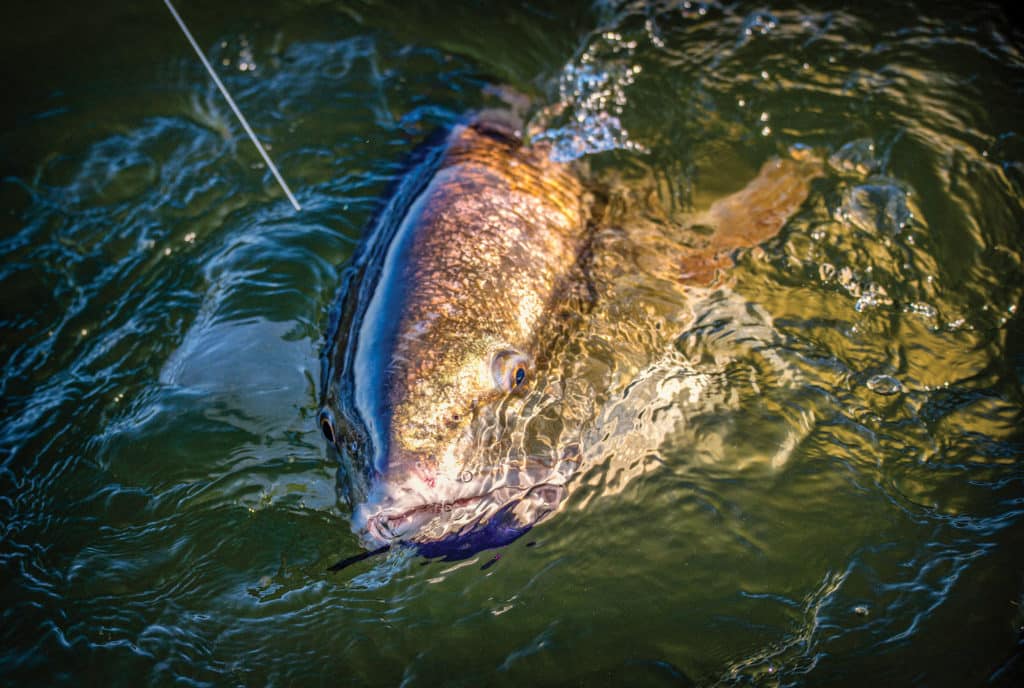
East Central Florida
An algae bloom in 2016 changed how anglers fish for redfish in the Mosquito Lagoon, the Banana River and the Indian River. The algae killed thousands of acres of seagrass in a region that produced some of the state’s biggest redfish.
“The algae bloom made our redfishing totally different than it used to be,” says Capt. Troy Perez of Mims, Florida. “We used to sight-fish schools of 200 to 500 fish pretty much year-round. We still catch them, but we catch them mostly now by cut-baiting or live-baiting, and sitting there and waiting for a fish without really seeing him.
“We used to catch 40-inch fish, and it’d be nothing to catch 20 in a day, and that was pretty much all year-round. Now a good day is four or five of those big suckers, actually two or three sometimes.”
Read Next: Catch Jumbo Florida Redfish
Perez, who specialized in fishing the shallow lagoon and the Indian River, now only sees schools of reds on his bottom recorder in much deeper water.
“The bigger fish are at the inlets more now, like at Ponce Inlet or at Port Canaveral,” says Perez, adding that he also catches redfish around the buoys marking the port channel. “Last fall, I marked a school. I don’t know how many there were, but I remember catching over 30, and my buddy next to me caught 30 or 40 of like 35- to 40-something-inch fish.”
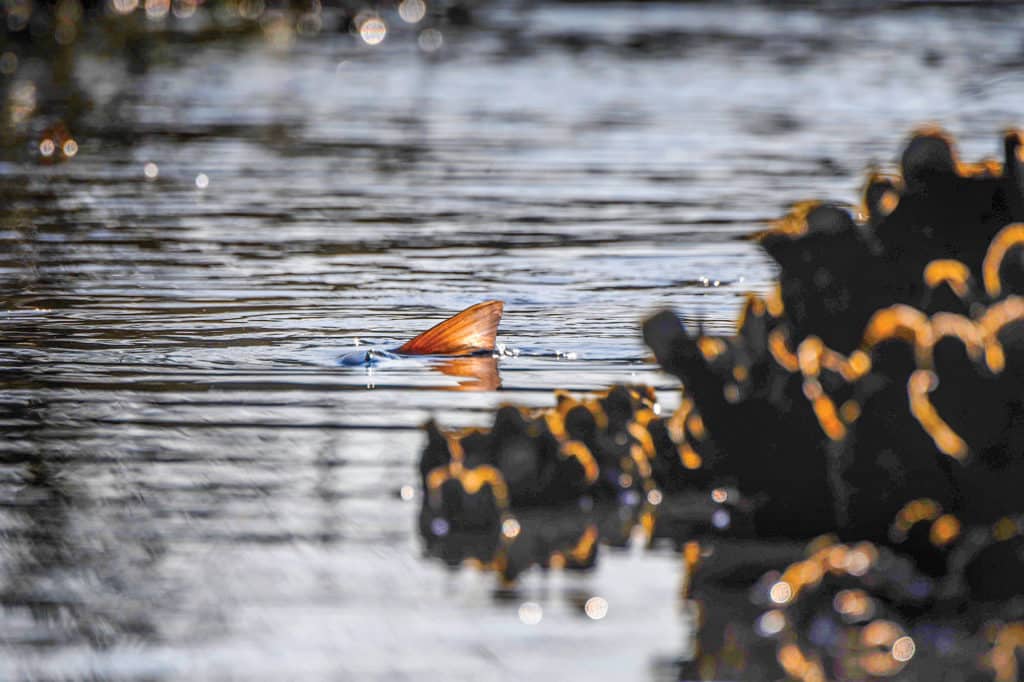
Perez uses Penn 30-pound-class spinning outfits when fishing inlets and the beaches near them. He ties a Bimini twist in the braided main line and connects it with a double uni-knot to 3 feet of 40- or 50-pound Cortland fluorocarbon leader. The beefier tackle allows his customers to land big reds as well as snook, cobia, sharks and goliath grouper.
When he marks fish, he’ll drop down a mullet head or half a crab on a circle hook or a 1/8-ounce jig head.
Inshore, Perez fishes cut bait on the bottom in places where he’d seen schools of redfish before the algae bloom, like along the west side of the Banana River, opposite Patrick Air Force Base.
“My favorite bait is a live or cut fresh pinfish, but the grass is gone, so it’s hard to get pinfish,” says Perez, who also uses fresh or frozen mullet, or half a fresh crab that he cuts with scissors.
He puts the baits on a 4/0 J hook, attached to 3 feet of 30- or 40-pound monofilament leader tied to 12- or 15-pound braided line, and fishes it on a 7-foot spinning rod with a Penn Slammer reel.
“Most of the time, I’m catching slot-size -redfish from 18 to 27 inches,” says Perez, who also catches seatrout, black drum and tarpon. “I fish points mostly. We look for mullet. Anytime you’ve got a point and a big school of big mullet around it, that’s where you want to fish.” —Steve Waters
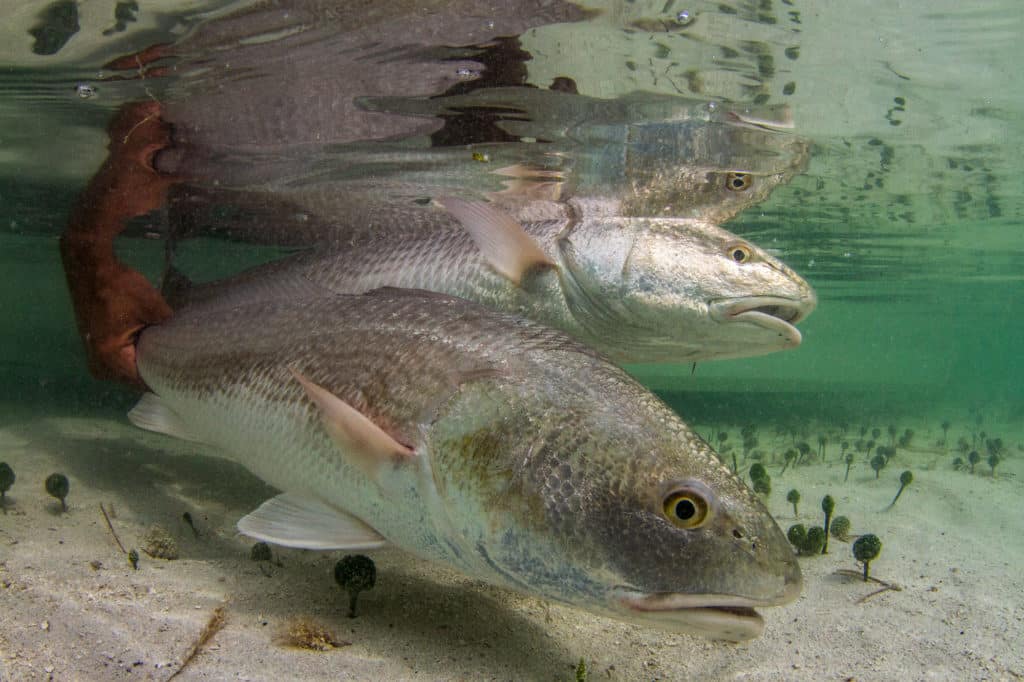
North Florida to the Mid-Atlantic
From northeast Florida to the mouth of Chesapeake Bay, extensive low-country habitat offers excellent redfishing opportunities. Fertile estuaries, marshes, countless oyster bars, mudflats, and the tidal creeks that connect many to the Intracoastal Waterway or coastal rivers support large numbers of reds, including trophies. Georgia’s Golden Isles, South Carolina’s St. Helena Sound, and the stretch from Kiawah Island to Cape Romain are prolific redfishing grounds. In North Carolina, the areas surrounding Swansboro, Bogue Sound, Neuse River, Cape Lookout National Seashores and Pamlico Sound are all top-notch.
Northeast Florida has one of the most vibrant redfish populations in the country. “It’s amazing how this fishery has come back and how we’ve been able to maintain it,” says Capt. Chip Wingo of Fishdaflats Charters, who explains that redfish are abundant all year, but things really light up from October through December. “In October,” he says, “the big bulls move into the rivers to spawn, and the opportunity to catch multiple big fish is incredible.” By big fish, Wingo means hefty 38- to 46-inch bull reds.
For even bigger fish, travel about 500 miles north to lower Pamlico Sound in North Carolina, renowned for its monster reds, which come into the sound and adjacent rivers to spawn. They start showing up in July and, according to Capt. Chris Kimrey of Mount Maker Charters in Atlantic Beach, North Carolina, the best action with huge redfish takes place in August and September.
For Kimrey, the ideal outfit to fish from an anchored boat is a 7-foot rod rated for 30- to 65-pound braid, and a 5500- or 6500-class spinning reel loaded with 50- to 60-pound braid. He likes this heavy setup because it makes for a short fight, leading to a quick release.
Read Next: Redfish Techniques for Tough Fishing Conditions
Kimrey also suggests using popping corks and artificials—including bucktails and rattle baits—on lighter tackle. He pulls anchor to chase a big fish, if needed.
He swears by popping corks above jigs and soft-plastics. He suggests a 4-inch cork with 50-pound monofilament leader tied to a 1/4- to 3/8-ounce jig head. Though he’s caught big reds on just about every soft-plastic lure shape and color there is, he always starts with a white body with a chartreuse tail. Sometimes, however, it’s the darker colors with metal flakes that get the job done. If popping corks and plastics aren’t attracting big fish, Kimrey is quick to switch to a rattle bait, which he says is “the best of both worlds of noise and action, all in one easy-to-cast package.” —Sid Dobrin









